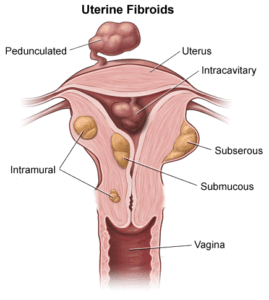
Definition
What are fibroids?
Fibroids are the most frequently seen tumors of the female reproductive system. Fibroids, also known as uterine myomas, leiomyomas, or fibromas, are firm, compact tumors that are made of smooth muscle cells and fibrous connective tissue that develop in the uterus. It is estimated that between 20 to 50 percent of women of reproductive age have fibroids, although not all are diagnosed. Some estimates state that up to 30 to 77 percent of women will develop fibroids sometime during their childbearing years, although only about one-third of these fibroids are large enough to be detected by a health care provider during a physical examination.
In more than 99 percent of fibroid cases, the tumors are benign (non-cancerous). These tumors are not associated with cancer and do not increase a woman’s risk for uterine cancer. They may range in size, from the size of a pea to the size of a softball or small grapefruit.
What causes fibroid tumors?
While it is not clearly known what causes fibroids, it is believed that each tumor develops from an aberrant muscle cell in the uterus, which multiplies rapidly because of the influence of estrogen.
Who is at risk for fibroid tumors?
Women who are approaching menopause are at the greatest risk for fibroids because of their long exposure to high levels of estrogen. Women who are obese and of African-American heritage also seem to be at an increased risk, although the reasons for this are not clearly understood.
Research has also shown that some factors may protect a woman from developing fibroids. Some studies, of small numbers of women, have indicated that women who have had two liveborn children have one-half the risk of developing uterine fibroids compared to women who have had no children. Scientists are not sure whether having children actually protected women from fibroids or whether fibroids were a factor in infertility in women who had no children. The National Institute of Child Health and Human Development is conducting further research on this topic and other factors that may affect the diagnosis and treatment of fibroids.
What are the symptoms of fibroids?
Some women who have fibroids have no symptoms, or have only mild symptoms, while other women have more severe, disruptive symptoms. The following are the most common symptoms for uterine fibroids, however, each individual may experience symptoms differently. Symptoms of uterine fibroids may include:
- Heavy or prolonged menstrual periods
- Abnormal bleeding between menstrual periods
- Pelvic pain (caused as the tumor presses on pelvic organs)
- Frequent urination
- Low back pain
- Pain during intercourse
- A firm mass, often located near the middle of the pelvis, which can be felt by the physician
In some cases, the heavy or prolonged menstrual periods, or the abnormal bleeding between periods, can lead to iron-deficiency anemia, which also requires treatment.
How are fibroids diagnosed?
Fibroids are most often found during a routine pelvic examination. This, along with an abdominal examination, may indicate a firm, irregular pelvic mass to the physician. In addition to a complete medical history and physical and pelvic and/or abdominal examination, diagnostic procedures for uterine fibroids may include:
- X-ray. Electromagnetic energy used to produce images of bones and internal organs onto film.
- Transvaginal ultrasound (also called ultrasonography). An ultrasound test using a small instrument, called a transducer, that is placed in the vagina.
- Magnetic resonance imaging (MRI). A non-invasive procedure that produces a two-dimensional view of an internal organ or structure.
- Hysterosalpingography. X-ray examination of the uterus and fallopian tubes that uses dye and is often performed to rule out tubal obstruction.
- Hysteroscopy. Visual examination of the canal of the cervix and the interior of the uterus using a viewing instrument (hysteroscope) inserted through the vagina.
- Endometrial biopsy. A procedure in which a sample of tissue is obtained through a tube which is inserted into the uterus.
- Blood test (to check for iron-deficiency anemia if heavy bleeding is caused by the tumor).
Treatment for fibroids
Since most fibroids stop growing or may even shrink as a woman approaches menopause, the health care provider may simply suggest “watchful waiting.” With this approach, the health care provider monitors the woman’s symptoms carefully to ensure that there are no significant changes or developments and that the fibroids are not growing.
In women whose fibroids are large or are causing significant symptoms, treatment may be necessary. Treatment will be determined by your health care provider(s) based on:
- Your overall health and medical history
- Extent of the disease
- Your tolerance for specific medications, procedures, or therapies
- Expectations for the course of the disease
- Your opinion or preference
- Your desire for pregnancy
